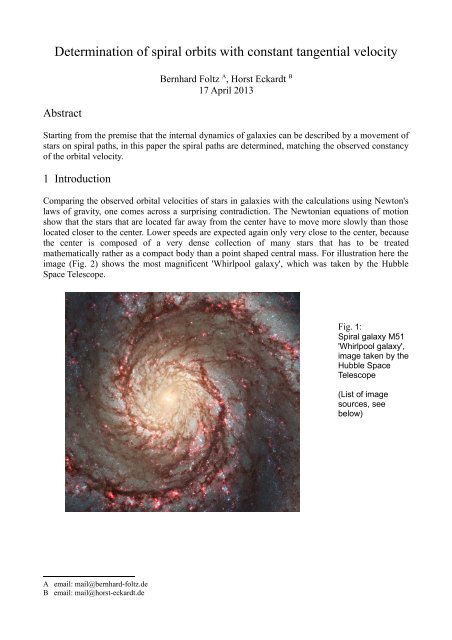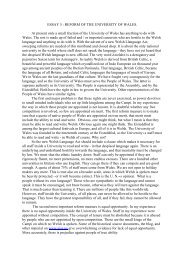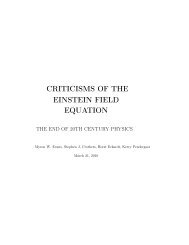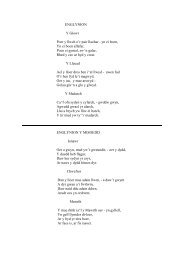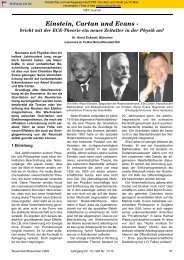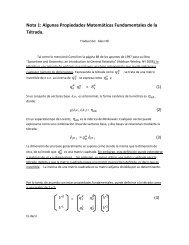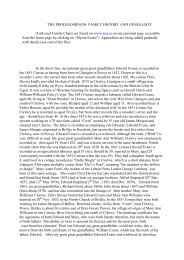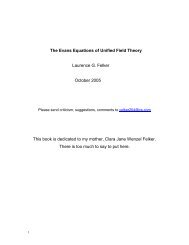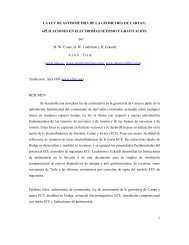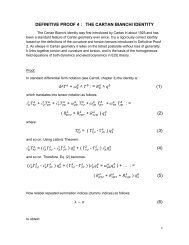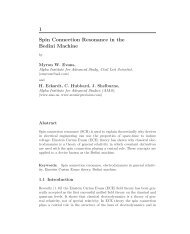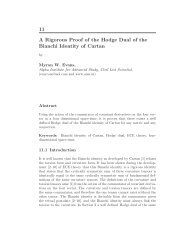Determination of spiral orbits with constant tangential velocity - English
Determination of spiral orbits with constant tangential velocity - English
Determination of spiral orbits with constant tangential velocity - English
Create successful ePaper yourself
Turn your PDF publications into a flip-book with our unique Google optimized e-Paper software.
<strong>Determination</strong> <strong>of</strong> <strong>spiral</strong> <strong>orbits</strong> <strong>with</strong> <strong>constant</strong> <strong>tangential</strong> <strong>velocity</strong><br />
Abstract<br />
Bernhard Foltz A , Horst Eckardt B<br />
17 April 2013<br />
Starting from the premise that the internal dynamics <strong>of</strong> galaxies can be described by a movement <strong>of</strong><br />
stars on <strong>spiral</strong> paths, in this paper the <strong>spiral</strong> paths are determined, matching the observed constancy<br />
<strong>of</strong> the orbital <strong>velocity</strong>.<br />
1 Introduction<br />
Comparing the observed orbital velocities <strong>of</strong> stars in galaxies <strong>with</strong> the calculations using Newton's<br />
laws <strong>of</strong> gravity, one comes across a surprising contradiction. The Newtonian equations <strong>of</strong> motion<br />
show that the stars that are located far away from the center have to move more slowly than those<br />
located closer to the center. Lower speeds are expected again only very close to the center, because<br />
the center is composed <strong>of</strong> a very dense collection <strong>of</strong> many stars that has to be treated<br />
mathematically rather as a compact body than a point shaped central mass. For illustration here the<br />
image (Fig. 2) shows the most magnificent 'Whirlpool galaxy', which was taken by the Hubble<br />
Space Telescope.<br />
A email: mail@bernhard-foltz.de<br />
B email: mail@horst-eckardt.de<br />
Fig. 1:<br />
Spiral galaxy M51<br />
'Whirlpool galaxy',<br />
image taken by the<br />
Hubble Space<br />
Telescope<br />
(List <strong>of</strong> image<br />
sources, see<br />
below)
The computed <strong>velocity</strong> distribution using Newton's gravitational equations is shown in the<br />
following diagram as compared <strong>with</strong> the measured velocities <strong>of</strong> the stars.<br />
Fig 2: Rotational speed V in dependence <strong>of</strong> the distance R to the center.<br />
The green line shows the expected speed according to Newton, which decreases towards the<br />
outside, and the gray-dashed line the decrease very close to the center.<br />
Near to the center, the measured <strong>velocity</strong> agrees really well <strong>with</strong> the calculation. However, for<br />
greater distances from the center a surprising discrepancy appears. The measured velocities are<br />
nearly independent from the distance to the center. The red curve shows the measurement four our<br />
own Milky Way, but is also true for other <strong>spiral</strong> galaxies.<br />
To bridge this gap between the calculation according to Newton and the observation, in the<br />
established physics additional Dark Matter is postulated, whose nature is still unknown.<br />
The ECE theory is treading a different path instead. It is assumed that the stars do not circulate in<br />
nearly circular <strong>orbits</strong> around the center but move in a <strong>spiral</strong> path from their origin at the center to<br />
the outside. Thereby a gravitational torsion field is assumed, that has to be described in other ways<br />
than according to Newton.<br />
One class <strong>of</strong> such <strong>spiral</strong> <strong>orbits</strong>, the Hyperbolic Spiral, was described in a previous paper [1] and<br />
made visible by an animation program [2], see Fig. 3.
2 Calculation<br />
Fig. 3:<br />
Animation <strong>of</strong> the<br />
star movement<br />
following a<br />
Hyperbolic Spiral.<br />
In the present work now <strong>spiral</strong> paths will be determined that match the <strong>constant</strong> <strong>velocity</strong> <strong>of</strong> the star<br />
in the exterior <strong>of</strong> the galaxy as accurately as possible.<br />
As an approach a <strong>spiral</strong> path is selected in which both the angle and the radius are exponential<br />
functions <strong>of</strong> time.<br />
θ=θ 0( t<br />
A<br />
)<br />
t 0<br />
r=r 0( t<br />
B<br />
)<br />
t 0<br />
The special case A= -1 and B=1 results in the above mentioned hyperbolic <strong>spiral</strong>.<br />
It is now requested that the <strong>velocity</strong> <strong>of</strong> the star is a <strong>constant</strong>, in particular, regardless <strong>of</strong> their<br />
distance r to the center.<br />
v T (t ,θ (t) , r(t ))=const. (3)<br />
In the present consideration, only the <strong>tangential</strong> component <strong>of</strong> the <strong>velocity</strong> is taken into account,<br />
which is the perpendicular to the radius extending component <strong>of</strong> the <strong>velocity</strong> – also named as<br />
angular or azimuthal component. It is the product <strong>of</strong> the temporal change <strong>of</strong> the angle θ and the<br />
distance r from the center.<br />
(1)<br />
(2)
vT=r d<br />
(θ) (4)<br />
dt<br />
Inserting the above equations (1) and (2) yields<br />
vT=r 0( t<br />
B<br />
d<br />
)<br />
t0 dt (θ 0( t<br />
A<br />
) ) (5)<br />
t 0<br />
v T=r 0<br />
t B<br />
t 0<br />
B A θ 0<br />
v T= A r 0θ 0<br />
t A−1<br />
A (6)<br />
t 0<br />
A+ B−1<br />
t<br />
A+B (7)<br />
t 0<br />
In order to satisfy the required condition, namely the constancy <strong>of</strong> vT, the exponent <strong>of</strong> t must be<br />
zero.<br />
A+ B−1=0 (8)<br />
Using this result, for a given exponent A, the exponent B can now be determined.<br />
B=1−A (9)<br />
In the above equations (1) and (2)<br />
θ=θ 0( t<br />
A<br />
)<br />
t 0<br />
r=r 0( t<br />
B<br />
)<br />
t 0<br />
B can now be inserted<br />
r=r 0( t<br />
1− A<br />
)<br />
t 0<br />
whereby the constraint ensures that r is not <strong>constant</strong> as well. Dissolved after time t this equation<br />
gives<br />
t=t 0( r<br />
)<br />
r0 (10)<br />
(11)<br />
(12)<br />
1<br />
1− A<br />
(13)<br />
and inserted into (1 / 10), finally yields the desired <strong>spiral</strong><br />
A<br />
θ=θ 0( r 1−A ) ; A≠1 (14)<br />
r 0<br />
The resulting functions r(t) and θ(t) show for the following ranges different behaviors <strong>with</strong><br />
increasing t:
A1 : θ increases , r decreases<br />
For A > 1, the stars are moving from the outside inwards, not fulfilling the premise. Also the special<br />
cases A = 0 and A = 1 should be excluded from the animation.<br />
3 Animation<br />
Based on the determined formulas, an animation program was written. The used programming<br />
language is Delphi 2007.<br />
Fig. 4: Animation <strong>of</strong> a <strong>spiral</strong> form similar to the Whirlpool galaxy<br />
In the animation, the <strong>velocity</strong> distribution is shown <strong>with</strong> red lines as a function <strong>of</strong> the radius. The<br />
lines are interrupted by green pixels. The lower part <strong>of</strong> the lines corresponds to the <strong>tangential</strong><br />
component <strong>of</strong> the <strong>velocity</strong>, and the entire line equals the total rate which is composed <strong>of</strong> <strong>tangential</strong><br />
and radial component. It is clearly apparent that in this example the overall rate is only slightly<br />
above the <strong>tangential</strong> speed. For not too short distances from the center, the results from the<br />
animation are quite well in line <strong>with</strong> the measured values <strong>of</strong> Fig. 2.<br />
(15)
References:<br />
[1] M. W. Evans, H. Eckardt, B. Foltz, R. Chechire Applications <strong>of</strong> ECE theory: the relativistic<br />
kinematics <strong>of</strong> <strong>orbits</strong> AIAS website, 2013, http://www.aias.us/documents/uft/a238thpaper.pdf<br />
[2] B. Foltz Animation program AIAS website, 2013,<br />
http://www.aias.us/documents/LectureMaterials/Galaxy.zip<br />
Image sources:<br />
1 Image is part <strong>of</strong>:<br />
NASA, ESA, M. Reagan and B. Whitmore, R. Chandar, S. Beck<strong>with</strong>, Hubble Heritage Team<br />
Spiral Galaxy M51, Hubble Space Telescope, NASA website, 2013,<br />
http://www.nasa.gov/images/content/509938main_whirlpool_lg.jpg<br />
2 Image created <strong>with</strong> use <strong>of</strong>:<br />
http://physics.uoregon.edu/~jimbrau/BrauImNew/Chap25/6th/25_01Figureb-F.jpg (21.3.2013),<br />
http://abyss.uoregon.edu/~js/images/gal_rotation.gif (21.3.2013),<br />
http://www.spitzer.caltech.edu/uploaded_files/images/0008/1661/ssc2008-10a_Ti.jpg (21.3.2013),<br />
http://www.spitzer.caltech.edu/uploaded_files/images/0003/1669/ssc2008-10b_Ti.jpg (21.3.2013)<br />
3 M. W. Evans, H. Eckardt, B. Foltz, R. Chechire Applications <strong>of</strong> ECE theory: the relativistic<br />
kinematics <strong>of</strong> <strong>orbits</strong> AIAS website, 2013, http://www.aias.us/documents/uft/a238thpaper.pdf


